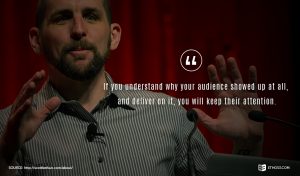Congrats! Your first book got published. Or maybe that article you have spent months researching will be featured in a magazine. But just before you can celebrate, you are asked to give a presentation in front of real, live people. No need to freak out, because you already have many skills to set up a strong and effective presentation. Here are some tools for writers to practice while preparing their presentation.
A Writer’s Guide to Preparing a Presentation
What Makes a Great Writer and What Makes a Great Presentation? Storytelling.
Research has shown that storytelling activates more parts of the brain. Not only is your audience engaged in your presentation, they will feel an emotional connection to what you are saying. When we hear a story, our brain searches for a similar experience we have gone through to create an understanding of what we are hearing.
For more tips on incorporating a story in your presentations, check out: How Storytelling Impacts Your Influence
Think Active, Not Passive.
One trick to keep your presentation moving along and staying on topic is to be in the now, not the then. Writing in an active voice will keep your sentences concise and to the point. After all, the word “present” is in the word “presentation.” Instead of, “She caught the ball;” say “she catches the ball.” Not only will this make the writing easier on you, active expressions will keep your audience in the here and now. If you find yourself writing in the past tense, you can use this guide to help you convert your thoughts over to active language.
Remember your Audience.
Why are people coming to watch you speak? What information are you assigned to give them? Or what do you want the audience to know? These questions should be the main focus of your presentation. Scott Berkun, author of “The Confessions of a Public Speaker” stresses this point:

“The majority of speakers fail at this, focusing on what they themselves wish to speak about, or what their slides will look like, rather than their audience. Speaking, like writing, is an ego trap. It’s not about you, it’s about them: what questions do they want answered? What stories did they come to hear? If you understand why your audience showed up at all, and deliver on it, you will keep their attention.”
As you prepare, double-check to make sure you don’t wander off topic or fail to deliver the point of your presentation to your audience.
Learn from the Pros.
Many professional writers have ventured onto the stage to present their work, whether it’s for a book reading, a Q-and-A session, or an interview. A simple way to prepare for a presentation is to observe professionals, and steal from their book. Ask yourself what you liked and disliked, what was the most memorable, and pay attention to their speech and body movement.
A web search will lead you to millions of different presentations, so start by looking up your favorite writer; my personal favorite is the late author and actress Carrie Fisher. She took her bestselling memoir “Wishful Drinking” and turned it into a successful one-woman show for the stage and HBO. Her style leans more on the entertainment side, but there are traits in her that every great public speaker should have: confidence, timing, humor, stage presence. Look up someone you admire and take notes on what they are doing that leaves an impression on you.
What Type of Presenter are You?
Writers come in all shapes and sizes and personalities. Don’t force yourself to be something you are not. Instead, find out what innate traits you already possess, and hone in on your strengths. Presentation experts at Ethos3 have put together an assessment, which reveals what presenter profile best fits you. From there, you can learn what skills you are naturally strong at, and which areas you need to focus on improving. The test only takes minutes, and it can help you better understand yourself as a presenter.
A writer normally does not get much opportunity to see their audience react to their work from behind the pages. But when a writer is asked to speak in front of a crowd, getting a reaction and leaving an impact are important to delivering a great presentation. The easiest way for a writer to slip comfortably into a presenter’s shoes is to start with what they know: storytelling, grammar, and research. As a writer, you have already mastered the majority of the work. This guide will hopefully serve as a great tool for practice when you prepare for your next presentation.
To find out more ways to get your presentation started on the right foot, check out our other blogs:
The Complete Guide to Practicing Before a Presentation